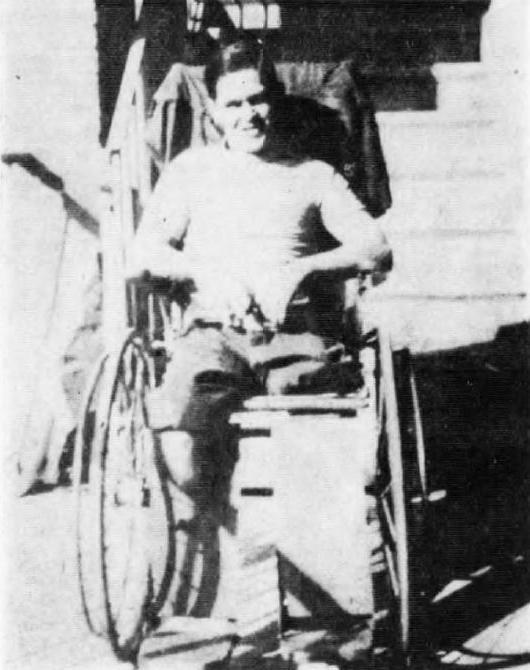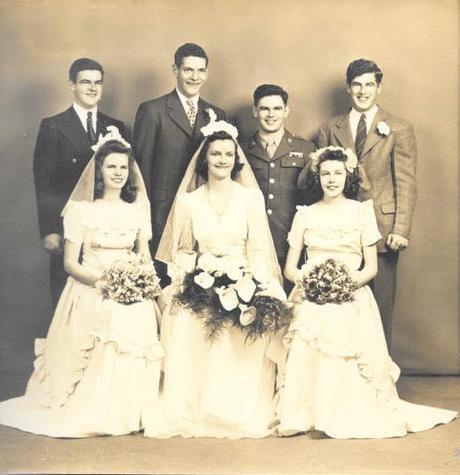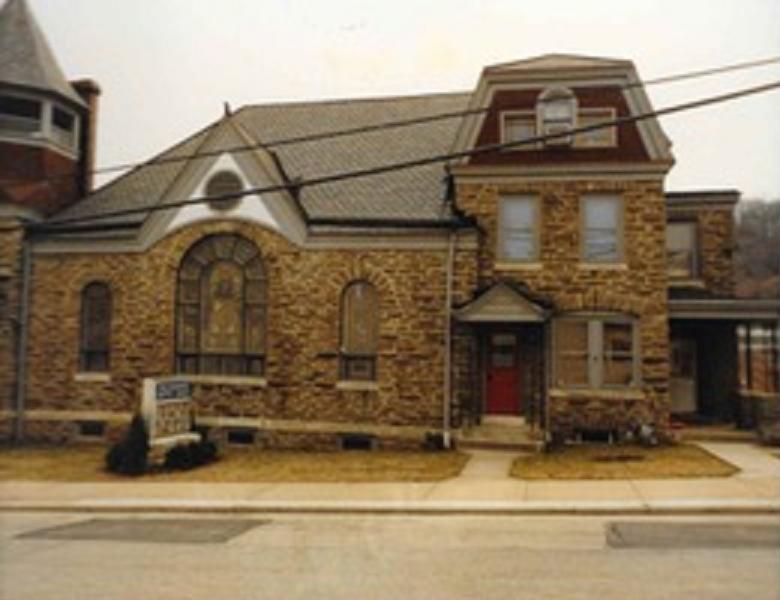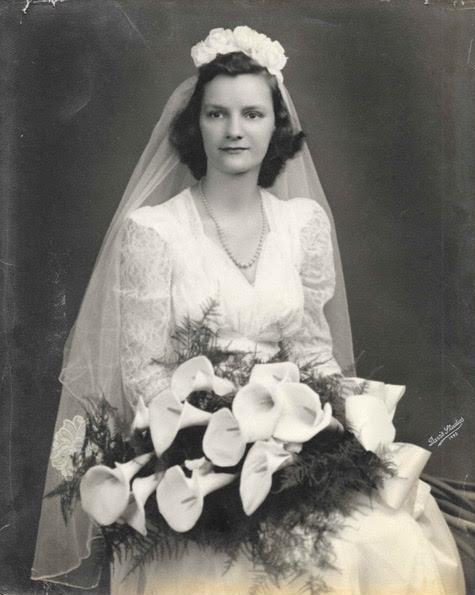Mr. Aubrey (Sam) Holland and Miss Doris Jane Ruth grew up in West Conshohocken.
Their families lived one-half of a block from each other.
Times were very different in the 1930’s and 1940’s in the Freedom Valley.
There were no high-rise office buildings lining Front Street.
There was no Schuylkill Expressway.
Each town – including West Conshohocken – had their own schools.
Streets, sidewalks, houses, and just about everything else was designed and built for people who had all four limbs working well.
Families were much larger at this time.
Young children did not always live into adulthood.
A college education was not needed to get a good job.
A high school education was not always typical.
Mr. Holland was one of 15 children, only 12 of whom made it to adulthood. Twins died in childbirth. A third child died at about the age of two years.
He was expelled from school in 8th grade.
Miss Ruth was one of 8 children, four of which were full siblings.
She quit school in 11th grade to go to work.
They were almost next-door neighbors, with Mr. Holland growing up in a home at Spring Garden and Spruce Streets in West Conshohocken; the Ruth family house was on Crawford Hill.
Sam and Doris became sweethearts. They loved each other.
The only long period of time that seemed to separate them was when Mr. Holland went into the military in 1943.
This was the time of World War II.
He became a Private in the United States Army and served as a medical corpsman.
He served in Cassino, Italy.
The top photograph shows Monte Cassino. The site overlooks the Rapido River.
Battles here were critical for the Allied Forces to be able to travel to Rome to liberate that city from Nazi occupation and to secure the freedom of the Italian people.
It was in Cassino where Private Holland suffered grievous wounds while providing aid to other members of the military on the battlefield.
Both of his legs were eventually amputated.
Those injuries did not keep Sam and Doris separated.
It was after he returned home from war that the extent of their love for one another became apparent to others.
Their love for one another provided hope for a nation.
Their love was highlighted throughout the United States and in other nations at a time when men serving in war wondered would their sweetheart would be waiting for them. Whether their sweetheart would want them back if they returned home wounded.
It was a time when the women waiting for their men to come home wondered whether they could handle the difficulties if their sweetheart came would come home injured.
It was not a pleasant conversation for a nation.
In most cases, the discussions – if they occurred at all – were done quietly. In private.
You ask people to go to war, and you hope that everyone comes home.
Yet, you know that many will not come home.
And others, they will come home – changed.
Sometimes, physically altered because of injuries.
Sometimes, mentally altered because of what they went through and what they witnessed.
You hope that their loved ones will accept and help the men when they return home.
Yet, you know that many will suffer. In silence.
The love between Sam and Doris was highlighted in newspapers coast-to-coast and around the world.
Her willingness to proceed. His willingness to proceed.
Both gave hope to others who were facing similar situations and, more likely, for those who feared having to face similar situations.

Private Holland returned to the United States on June 14, 1944 – Flag Day – according to a news article dated February 8, 1946, in The Conshohocken Recorder.
Doris had been “his best girl”, according to that account in the newspaper. Upon his return to the United States, Sam told Doris that she “had better not wait for him, as he was pretty badly shot up.”
Doris went to visit Sam at the Walter Reed General Hospital on July 4, 1944.
She left her job in Manayunk and took a job at the post exchange at the hospital in Washington, according the newspaper article, so she could be near Sam every day. She stayed in Washington through December.
On August 1, 1944, Miss Doris Jane Ruth, 17 years of age, and Private Aubrey (Sam) Holland, 24 years of age, announced their engagement to marry, according to a news article of the same date in The Conshohocken Recorder.
In a news article dated August 17, 1944, The Stars and Stripes reported that Private Holland had told his high school sweetheart “I guess you better not wait for me honey. I’m pretty badly banged up.” Miss Ruth, the newspaper reported, “thought differently. ‘No matter what’s happened or what’s left of you I still love you and I want you.’”

Their marriage plans and then the marriage itself were national and international news.
Sam and Doris had become symbols to many throughout the nation.
That a man and woman could put aside war injuries and proceed with marriage was an important statement at a time when many, many men were returning home – and would be returning home – changed.
Physically in some cases.
Mentally in other cases.
In some cases, both physically and mentally.
The term “PTSD” (Post-traumatic stress disorder) was not in use at this time.
In World War I and in years afterwards, the term “Shell Shock” was used.
In World War II and for some time afterwards, the military used the term “Combat Stress Reaction” or “CSR”. It was also known as “Battle Fatigue”.
Few talked about the difficulties.
But people recognized that their husband, their father, their son, their brother, their uncle, their cousin, their best buddy had changed.
Under the title of “Real Test of Love”, The Daily Courier of Connellsville, Pennsylvania, in an editorial on August 21, 1944, wrote that “What may happen to a soldier sweetheart in war as affecting the future often intrudes itself on the girl left behind. She cannot but think that he may come home blind or with a leg or arm or both missing. The problem is a real one.” The newspaper then cited Sam and Doris as an example of an engaged couple that they hoped might become typical.
Sam and Doris were quite open in their convictions.
That nothing – literally, nothing – was going to keep them apart.
They would be married.
And they would make a live together. A life worth living.
On March 16, 1945, in a news article on the front page of The Des Moines Register, Miss Ruth was quoted as saying that Private Holland “had been afraid of being a burden on her.” Her response? “That’s just plain silly and I showed him why,” the newspaper reported. “He can earn a living, he can go anywhere I can go, and our lives won’t be any different than if this hadn’t happened. I told him a girl doesn’t stop loving a fellow just because he loses an arm or a leg. He is still there, and that’s all that counts.”
The Press Democrat of Santa Rosa, California, in a news article of the same date included additional quotes from Miss Ruth: “Don’t marry out of pity. Marry for love. There’s nothing that kills a man’s spirit as much as knowing he is pitied. If a girl really loves her man, she has no doubts – no matter how badly he’s injured – but if she begins to feel more sorry for him than anything else, she’d better call it quits.”
In an editorial dated November 1, 1944, in the Perry County Democrat of New Bloomfield, Pennsylvania, spoke of their admiration for Doris. “My hat is off to a girl, Doris Jane Ruth, 19, West Conshohocken, down near Philadelphia…God bless women like that. She is as great heroine as is her friend a hero.”

When they married on March 31, 1945, at the Balligomingo Baptist Church in West Conshohocken, Sam was 24 years old and Doris was 18 years old.
At the time of the wedding, Sam was about four months into using artificial limbs to walk.
Without aid from others, Sam used two canes to walk independently much of the time.
On arrival at the Church for the wedding, two of his brothers, George and Robert Holland, helped him as he walked up the steps of the Church.
At their wedding, Sam walked down the aisle with the aid of a cane and the assistance of George Holland, his best man.
The headline for the photo on the front page of The Philadelphia Inquirer on April 1, 1945, of the beaming bride and groom: “Hero Weds Former Sweetheart”
In that news article, The Philadelphia Inquirer reported that the wedding went on as planned. Private Holland wore his military uniform. He had been awarded both the Silver Star and the Purple Heart with an Oak Leaf Cluster for his service to the American people. He had only recently been released from the Walter Reed General Hospital in Washington, District of Columbia.
The news article noted that Private Holland served as a medic and “was wounded while aiding buddies during the crossing of the Rapido River in Italy in January of 1944. After being lost for four days on the battlefield, he was finally rescued and one leg was amputated immediately. Later, his other leg was removed.”
The top headline of the photo of the new husband and wife on the front page of The Conshohocken Recorder on April 3, 1945: “In Wedding of Nation-Wide Interest”. Underneath the photo were further headlines: “West Borough’s No. 1 Hero Weds Loyal Sweetheart Sat’y as Large Assemblage Looks on”.
The news article quotes Doris as stating the wedding was one that she “had always dreamed of”.
One of two celebrants performing the wedding, The Rev. Lynn Van Syckel, was quoted in a news article dated April 1, 1945, in The Courier-Journal in Louisville, Kentucky. The minister indicated that he had known both the groom and the bride for much of their lives. “He described [Mr.] Holland as ‘a spunky youngster with the kind of character that will carry him through anything,’” reported the newspaper. “Doris Jane, he said, is ‘the kind of a girl who will never let him feel sorry for himself.’”

After the wedding, Sam and Doris moved into a three-room apartment on Ford Street in West Conshohocken.
And started their life together.
To make life worth living.
Part IV will explain the ups and downs – the human frailties – and the love between this family and their neighbors throughout the Freedom Valley. Part IV will be published tomorrow.
Part V will give a perspective from Jewish individuals on how human compassion and kindness could occur in the midst of a hellish situation. Part V will be published on Sunday.
These news columns may give you hope and give you reason to offer thanks on this Thanksgiving Day Holiday Weekend.
Note:
In Part II, reference was made as to whether Private Holland went to two hospitals when he returned to the United States from Italy or whether he went directly to the Walter Reed General Hospital.
Most news articles focused on treatment that Private Holland received at the Walter Reed General Hospital and did not make mention of an initial stay at another hospital. The Washington Post, though, noted in a news article dated August 16, 1944, that Private Holland went first to a hospital in West Virginia and that he was later moved to the Walter Reed General Hospital in Washington, District of Columbia.
A news article in The Conshohocken Recorder dated June 23, 1944, has been located that indicated that Private Holland arrived at a hospital in Virginia on June 14, 1944 – Flag Day – and that he called his mother two days later to indicate that he was being transferred to another hospital – likely the Walter Reed General Hospital – for further treatment.
Thus, it is likely that Private Holland was initially admitted to another hospital when he returned to the United States and then was transferred to the Walter Reed General Hospital.
Whether that initial hospital was in West Virginia or Virginia is uncertain since the two newspapers have different accounts.
The photograph of Monte Cassino is courtesy of Mr. Mike Dean, 1992.
The photographs of the Holland Family are courtesy of Mr. Scott Holland, 1945.
The photograph of the Balligomingo Baptist Church is courtesy of Mr. Scott Holland, date uncertain.
Do you have questions about local history? A street name? A building?
Your questions may be used in a future news column.
Contact Richard McDonough at freedomvalleychronicles@gmail.com.
© 2018 Richard McDonough

